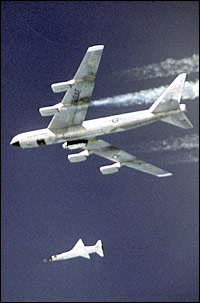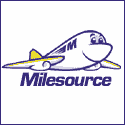
Updated: 09:26 AM EST
NASA's 5,000-MPH Jet Makes First Flight
By ROBERT JABLON, AP Writer
LOS ANGELES (March 28) - Three years after its first test flight ended in an explosion, NASA on Saturday successfully launched an experimental jet that the agency believes reached a record-setting speed of about 5,000 mph.

The unpiloted X-43A made an 11-second powered flight, then went through some twists and turns during a six-minute glide before plunging into the Pacific Ocean about 400 miles off the California coast.
"It was fun all the way to Mach 7,'' said Joel Sitz, project manager at NASA's Dryden Flight Research Center.
Flight engineer Lawrence Huebner said preliminary data indicated the needle-nosed jet reached a maximum speed of slightly over seven times the speed of sound, or about 5,000 mph, after a rocket boosted it to about 3,500 mph.
Huebner said it was the first time an "air-breathing'' jet had ever traveled so fast. The rocket-powered X-15 reached Mach 6.7 in 1967.
"It's a great way to end, certainly all the sweeter because of the challenges we've had to step up to and overcome through the life of this project,'' said Griffin Corpening, Dryden's chief engineer on the project.
The first X-43A flight ended in failure June 2, 2001, after the modified Pegasus rocket used to accelerate the plane veered off course and was detonated. An investigation board found preflight analyses failed to predict how the rocket would perform, leaving its control system unable to maintain stable flight.
NASA built the X-43A under a $250 million program to develop and test an exotic type of engine called a supersonic-combustion ramjet, or scramjet.
In theory, the air-breathing engine could propel an airplane to speeds of Mach 7 or faster, enabling around-the-world flights that would take several hours. The Department of Defense also is working on the technology, which it's eyeing for use in bombers that quickly could reach targets anywhere on the globe.
The 12-foot-long, 2,800-pound X-43A was mounted on a Pegasus rocket booster and carried to an altitude of 40,000 feet by a modified B-52 bomber, which took off from Edwards Air Force Base in the high desert.
A few seconds after the craft was dropped, the rocket flared, sending the jet skyward on a streak of flame and light. At about 100,000 feet, the rocket dropped away.
The scramjet took over, using up about two pounds of gaseous hydrogen fuel before gliding. Applause rang out in the control center at Dryden Flight Research Center at Edwards.
Technological hurdles mean it will be decades before such a plane could enter service. And NASA's role in developing the technology remains in doubt, as the agency recently cut funding for more advanced versions of the X-43A.
Engineers have pursued scramjet technology because it could allow rocket-speed travel but with considerable savings in weight. Rockets must carry their own oxygen to combust the fuel they carry aboard; scramjets can scoop it out of the atmosphere.
In scramjets, oxygen is rammed into a combustion chamber where it mixes with fuel and spontaneously ignites. To work, the engine must be traveling at about five times the speed of sound - requiring an initial boost that only a rocket can provide.
A third X-43A could fly as early as the fall.
Copyright © 2003 The Associated Press. All rights reserved. The information contained in the AP News report may not be published, broadcast, rewritten or redistributed without the prior written authority of The Associated Press.
AviationHistory.org shall not be liable for any errors or delays in the content, or for any actions taken in reliance thereon.
|














